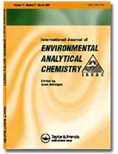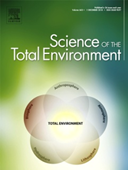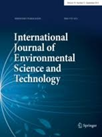
|
Optimisation of laboratory arsenic analysis for groundwaters of West Bengal, India and possible water testing strategy(International Journal of Environmental Analytical Chemistry)
(Kundu AK., Majumder S., Biswas A., Bhowmick S., Pal C., Mukherjee A., Majumder M., Chatterjee D,40266,,,Year : 2018)
|
Regularmonitoring of arsenic (As) in groundwater is crucial frompublic health perspectives as millions of people are suffering due to use of contaminated aquifer water for drinking purposes. The routine analyses, especially in developing nations, are mostly done in localised government/non-government laboratories with limited resources, having the target of analysing large number of samples in each run. Thus apart from analytical sensitivity, cost-effectiveness of the method and eco-friendliness of the experimental operation are key surreptitious factors. This demands optimisation of total As measurement methods and finding a method that gives ‘optimumbenefit’ considering all these factors together. The present study therefore evaluates four common As (total) measurement methods [iodometric- colorimetric method, silver diethyl dithiocarbamate method, molybdenum blue method and hydride generation atomic absorption spectrophotometric (HG-AAS) method] practised in the Bengal Delta Plain, in view of their analytical sensitivity, related environmental hazard and experimental costs. It was found that the HG-AAS method is analytically more sensitive, whereas the iodometric-colorimetricmethod and the molybdenum blue method are better choices in terms of eco-friendliness and cost-effectiveness, respectively. However, when all three factors (analytical reliability, environmental hazard and cost) are considered simultaneously, themolybdenumbluemethodwas found to be placed first in the ‘optimum performance rank’ list. It was also found that both environmental hazard and cost play a more crucial role than analytical reliability, although this is case specific andwould differ from place to place around the globe. Finally based on the results, we have hypothesised a water testing strategy for developing countries such as India where the molybdenum blue method can be adapted as a screening method and later the HG-AASmethod can be used to precisely identify the groundwater samples with As concentration below the WHO drinking water guideline value of 10 g/L.
|

|
Arsenic retention in cooked rice: Effects of rice type, cooking water, and indigenous cooking methods in West Bengal, India(Journal of Science of the Total Environment)
(Mandal U., Singh P., Kundu AK., Chatterjee D., Nriagu J., Bhowmick S.,40266,,,Year : 2018)
|
This study evaluated the concentration of arsenic in paired raw and cooked rice prepared by individual households in arsenic-endemic rural area of West Bengal. The aim was to investigate how the cooking habits of rural villagers of West Bengal might influence the arsenic content of rice meals. It was found that the use of arsenicrich groundwater for cooking could elevate the arsenic concentration in cooked rice (up to 129% above the raw sample), thereby enhancing the vulnerability of the rural population of West Bengal to arsenic exposure through rice consumption. The risk is heightened by the habit of drinking the stewed rice water (gruel) in the local communities. The cooking method employed, rice variety, background arsenic concentration in raw rice and cooking water arsenic concentration were found to be important predisposing factors that could affect the accumulation of arsenic in cooked form. The fundamental indigenous cooking practice followed by the villagers requires use of low-arsenic water for cooking as a necessary strategy to alleviate arsenic exposure in their staple food.
|

|
Worldwide distribution of polyclyclicaromatic hydrocarbons in urban road dust.(International Journal of Environmental Science and Technology)
(Majumdar, Deepanjan, Rajaram, B., Meshram, S., Suryawanshi, P., Rao, C. V. C. ,142,,397-420,Year : 2018)
|
Polycyclic aromatic hydrocarbons (PAHs) is considered as one of the most important groups of organic environmental contaminants due to their toxicity, persistence and ubiquity. PAHs have been monitored in urban road dust at various locations worldwide in about last three decades. Resuspension of road dust containing PAHs is an important route of PAHs exposure to humans. This paper collates the available information on reported concentrations of PAHs in urban road dust at various locations worldwide classified as industrial, residential, traffic, city and commercial and other areas, reported sources of PAHs in urban road dust and related interpretations. Also, available information has been reviewed and documented country-wise. Variation in PAHs concentrations over various worldwide locations have been scrutinized and interestingly, most of the reported average PAHs concentrations were found to be distributed within a very narrow range of values, implying only little variation in average PAH concentrations in spite of great distances between locations, climatic variation and differences in anthropogenic activity.
|

|
Characterization of Traffic Noise and Honking Assessment of an Indian Urban Road(Fluctuation and Noise Letters )
(Ritesh Vijay, T. Chakrabarti and Rajesh Gupta ,17,,31850031,Year : 2018)
|
|
To study the traffic noise on an Indian urban highway, traffic noise levels (Leq, Lpeak, Lmax and Lmin), traffic volume, speed and honking incidents were measured in peak traffic hours in the morning and evening. An attempt has been made to characterize the traffic noise including the impact of honking. Honking of horn was positively correlated with Leq and negatively correlated with traffic speed. In case of traffic volume and road width, no significant correlation was established with Leq. Based on the observed honking and Leq in each time interval, statistical analysis was performed for assessing the impact of honking on traffic noise and its estimation through trend analysis. Further, quantification of honking noise was carried out considering frequency analysis of audio spectrum of traffic noise. Both the analyzes confirm the honking contributed an additional noise of 1–4dB(A) over and above the traffic monitoring noise. The study suggests that honking noise must be included as a factor while monitoring traffic noise in some places where honking is common practice. This study will help in characterizing the traffic noise and the impact of honking for further abatement studies.
|

|
Interactive web-based data generation software applicable for river engineering(International Journal of Scientific Research in Computer Science Applications and Management Studies)
(Girish S. Katkar, Dinesh A. Lingote, Ritesh Vijay,7,6,,Year : 2018)
|
It's an era of automated system, many researching organizations are working on automated system to ease burden of conventional systems. Among all, if data generation system for large geographical area like: River modelling, Biodiversity and air quality monitoring is considered then conventional method used for data generation realizes burdensome, time consuming, never ending process and sometime fails even. Consequently, it is very essential to develop auto data generation techniques which will generate large data to support conventional method (form a team of researcher, carry-out field work, collect sample, test it with the instruments and generate data). This research paper introduces a web-based software developed for the Kanhan river to generate river water quality data for its modelling. Software uses different data generation techniques like: data extraction, data estimation, data generation using public-partnership and data generation using scientific software respectively. This research paper also demonstrates its public portal utilized for the public health management.
|

|
Responsive Information generation system for Kanhan River, an effective information system for river modelling(International Journal of Computer Sciences and Engineering)
(Dinesh A. Lingote, Girish S. Katkar , Ritesh Vijay , R. B. Biniwale,6,12,213-221,Year : 2018)
|
River is main source of water for drinking and domestic usage. Over exploitation and discharge of surface water in river stream has ecologically stressed the rivers. In view to manage river health, it is essential to carry out river engineering periodically. River follows complex structure; goes through dense forest and valleys. Therefore, measuring water quality and several other parameters associated with the river is a discouraging job. Mostly river follows longest path and generating data for such large geographical area is very challenging. Scientific study of the river requires data for several consecutive years. Having such large data requirement and expecting data generation simply through field-work is highly burdened and never ending process. Therefore, in this paper we introduced auto data generation techniques like: data extraction, data generation through public-partnership, data estimation and data generation using GIS (Geographic information system) based utility software. Lastly, we illustrate complete data generated by using these auto data generation techniques
|

|
Geospatial assessment of tourism impact on land environment of Dehradun, Uttarakhand, India(Environmental Monitoring and Assessment)
(Jaydip Dey,S. Sakhre, V. Gupta, Ritesh Vijay, Sunil Pathak, Rajesh Biniwale, Rakesh Kumar,190,4,181,Year : 2018)
|
India’s tourism industry has emerged as a leading industry with a potential to grow further in the next few decades. Dehradun, one of the famous tourist places in India located in the state of Uttarakhand, attracts tourist from all over the country and abroad. The surge in tourist number paved the way for new infrastructure projects like roads, buildings, and hotels, which in turn affects the topography of the mountainous region. In this study, remote sensing and GIS techniques have been used to assess the impact of tourism on the land environment of Dehradun. Satellite images of the years 1972, 2000, and 2016 were analyzed using objectbased image analysis (OBIA) to derive land use and land cover (LULC) and ASTER-DEM (Digital Elevation Model) was used to determine the topography of the study area. LULC classification includes built-up, vegetation, forest, scrub, agriculture, plantation, and water body. The slope of the region was categorized as gentle, moderate, strong, extreme, steep, and very steep. To assess the sprawl of built-up on high terrain land, built-up class of LULC was overlaid on slope classes. The overlay analysis reveals that due to increase in tourism, the land use in terms of the built-up area has been extended from gentle slope to very steep slope. The haphazard construction on the extreme, steep, and very steep slope is prone to landslide and other natural disasters. For this, landslide susceptibility maps have also been generated using multicriteria evaluation (MCE) techniques to prevent haphazard construction and to assist in further planning of Dehradun City. This study suggests that a proper developmental plan of the city is essential which follows the principles of optimum use of land and sustainable tourism.
|

|
Zooplankton diversity as indicators of pollution in warm monomictic Dal-Nigeen lake(Sustainable Water Resources Management)
(Dilip Meshram, D Catherine, N. Badhe, Snehal Khedkar, Ritesh Vijay Tapas Nandy ,4,4,897-904,Year : 2018)
|
The study aimed to assess the zooplankton diversity in Dal–Nigeen lake located in Srinagar, India. Zooplankton is a secondary producer which acts as the intermediate link between phytoplankton and fish in aquatic environment. Zooplankton diversity in the lake was monitored during autumn 2012 and summer 2013. Among zooplankton single species belonging to protozoa, 11 species to rotifera, 3 species to cladocera, and 2 species with single larval stage belonging to copepod were identified. Percent composition of zooplankton communities revealed that rotifera was the most dominant group followed by copepoda in summer, while rotifera was the most dominant group followed by cladocera in autumn season. The Shannon–Wiener diversity index (SWI) in summer varied from 1.29 to 3.63 and from 1.43 to 3.67 in autumn indicating moderate-to-good level of zooplankton diversity in the lake and low-to-medium impact of organic pollution from the anthropogenic activities. The study indicates that species abundance was lower in summer as compared to autumn season which may be due thereby to variation in environmental characteristics of the lake water.
|

|
Three-stage biological system for treatment of coke oven effluent(J. Hazard. Toxic Radioact. Waste)
(Maneesh, N., Bhuvanesh, S., Shaikh Z.A., Sreekrishnan T.R., Mazumdar, S.M., Choubey, M. J. ,22(3),,04018012,Year : 2018)
|
A three-stage continuous biological treatment system has been developed for removal of cyanide, phenol, organics, and ammonia from a coke oven effluent. Two stages of activated sludge treatment with completely mixed aeration tanks followed by a hybrid anoxic reactor, in series, were used. The hybrid anoxic reactor uses self-immobilized microbial biomass (granular sludge) under fluidized conditions. A 50??L/day pilot plant was evaluated for a period of over 6 months to monitor organics, ammonia, phenol, and cyanide removal. The activated sludge treatment systems were operated at a hydraulic retention time of 1 day and the hybrid reactor at 16 h. Major constituents of the effluent used in the study were cyanide (9–33??mg/L), phenol (21–235??mg/L), ammoniacal nitrogen (400–1,600??mg?NH3-N/L), organic load [400–1,500 mg chemical oxygen demand (COD)/L], and nitrate nitrogen (0–90??mg?NO3-N/L). Removal efficiencies were around 90% for organic load, 88% for ammoniacal nitrogen, 100% for nitrate nitrogen, and almost 99 and 100% for cyanide and phenol, respectively. The process is presently being scaled up to 1,000 L per day.
|

|
Rice husk-based superplasticizer to increase performance of fly ash based geopolymer concrete(Emerging Materials Research)
(Ramesh Kumar Chouhan, Manish Mudgal, Abhishek Bisarya, Avanish Kumar Srivastava ,,,,Year : 2018)
|
Workability is a major drawback of fly-ash-based geopolymers due to high viscosity. In this research, a new type of superplasticizer is developed to overcome this workability issue. Due to the high viscosity of geopolymeric binder structures, none of conventional superplasticizers was found effective in maintaining the viscosity of the mixture. The novel hybrid superplasticizer was developed by utilizing agrowaste-that is, rice husk-and an alkaline activator. Characterization studies [by X-ray diffraction, Fourier transform infrared spectroscopy and field emission scanning electron microscope] of the material indicated that the amorphous silica from rice husk reacts with the alkaline activator-that is, sodium hydroxide-and results in the in situ synthesis of sodium silicate and lignin. The developed superplasticizer was used in different percentages in fly-ash-based geopolymeric systems to study its engineering properties. The workability of the fresh geopolymer concrete was measured using the slump cone test method as per IS 1199-1959, while the compressive strength was evaluated as per IS 516-1959, and it is reported that the workability of the geopolymer concrete was improved significantly compared to that of conventional geopolymeric systems. In the present work, an attempt has also been made to establish a working mechanism for the developed superplasticizer with geopolymeric systems, which indicated its compatibility with [-Si-O-Al-O-] n networks.
|

|
Feasibility Studies for Development of Cement Free Fly Ash Based Geopolymer Mortar Using Potassium Based Alkaline Activator(International Research Journal of Engineering and Technology)
(Kritika Keshari, Manish Mudgal, Ramesh Kumar Chouhan, Abhishek Bisarya,5,4,,Year : 2018)
|
industrial waste in abundant quantity, like fly ash, red mud, etc. In this study class F fly ash sample which has been used was obtained from Satpura Thermal Power Plant, Sarni, Betul (M.P.). In this study potassium based alkaline activator (Combination of potassium hydroxide and potassium silicate) was used. In this research work the molarity of the solution was kept constant to be 16 and ratio of K2SiO3:KOH was varied. The ratios of K2SiO3:KOH adopted were 0.25, 0.50, 1.00, 1.50, 2.00, and 2.50. For each batch 15 cubes of sizes 7.06cm x 7.06cm x 7.06 cm were casted for each trial out of which 12 cubes were oven cured in Hot Air Oven at 60°C for 48 hours and the remaining 3 cubes were left for the ambient drying. For compressive strength testing, 3 cubes each were tested at 3, 7, 14 and 28 days respectively and the average of 3 cubes was taken as the compressive strength. It was found that initially on increasing the ratio of K2SiO3:KOH the compressive strength was increased but beyond ratio 0.50 the compressive strength was decreased. The compressive strength using 0.50 ratio of K2SiO3:KOH was found to be 85.20 MPa for oven curing at 60°C for 48 hours at 28 days of aging and 59.10 MPa for ambient curing at 28 days of aging where solution: fly ash ratio 0.27.
|

|
Effect of biochar on bio-electrochemical dye degradation and energyProduction(Bioresource Technology)
(Ayyappan, C.S., Bhalambaal, V.M.,Kumar, S.,251, ,,165-170,Year : 2018)
|
|
No information is available
|

|
Bioremediation and detoxification of industrial wastes by earthworms:Vermicompost as powerful crop nutrient in sustainable agriculture(Bioresource Technology)
(Bhat, S.A., Singh, S., Singh, J., Kumar, S., and Vig, A.P.,252, ,,172-179,Year : 2018)
|
Vermicompost is the final product of the vermicomposting process involving the collective action of earthworms and microbes. During this process, the waste is converted into useful manure by reducing the harmful effects of waste. Toxicity of industrial wastes is evaluated by plant bioassays viz. Allium cepa and Vicia faba test. These bioassays are sensitive and cost-effective for the monitoring of environmental contamination. The valorization potential of earthworms and their ability to detoxify heavy metals in industrial wastes is because of their strong metabolic system and involvement of earthworm gut microbes and chloragocyte cells. Most of the studies reported that the vermicompost produced from organic wastes contains higher amounts of humic substances, which plays a major role in growth of plants. The present article discusses the detoxification of industrial wastes by earthworms and the role of final vermicompost in plant growth and development.
|

|
Improving methane yield and quality via co-digestion of cow dung mixed with food waste(Bioresource Technology)
(Awasthi, S.K., Joshi, R., Dhar, H., Verma, S., Awasthi, M.K., Varjani, S., Sarsaiya, S., Zhang, Z., & Kumar, S.,251, ,,259-263,Year : 2018)
|
Methane (CH4) production and quality were enhanced by the co-digestion of cow dung and food waste (FW) mixed with organic fraction of municipal solid waste (OFMSW) under optimized conditions in bench and semi continuous-scale mode for a period of 30 days. A bacterium capable of high yield of CH4 was enriched and isolated by employing activated sewage sludge as the inoculums. The thirteen bacterial isolates were identified through morphological and biochemical tests. Gas chromatography was used to analyze the chemical compositions of the generated biogas. CH4 yields were significantly higher during co-digestion of Run II (7.59 L) than Run I (3.7 L). Therefore, the co-digestion of FW with OFMSW and Run II was observed to be a competent method for biogas conversion from organic waste resources.
|

|
Biodegradation of food waste using microbial cultures producing thermostable -amylase and cellulase?under different pH and temperature(Bioresource Technology)
(Awasthi, M.K.,Wong,J.W.C., Kumar,?S., Awasthi,S.K.,Wang, Q., Wang, M.,Ren, X., Zhao, J.,Chen, H., & Zhang, Z.,248, ,,160-170,Year : 2018)
|
The aim of this work was to study the biodegradation of food waste employing thermostable a-amylase and cellulase enzymes producing bacteria. Four potential isolates were identified which were capable of producing maximum amylase and cellulase and belong to the amylolytic strains, Brevibacillus borstelensis and Bacillus licheniformis; cellulolytic strains, Bacillus thuringiensis and Bacillus licheniformis, respectively. These strains were selected based on its higher cell density, enzymatic activities and stability at a wide range of pH and temperature compared to other strains. The results indicated that 1:1 ratio of pre and post consumed food wastes (FWs) were helpful to facilitate the degradation employing bacterial consortium. In addition, organic matter decomposition and chemical parameters of the end product quality also indicated that bacterial consortium was very effective for 1:1 ratio of FWs degradation as compared to the other treatments.
|

|
Role of saw dust and cow dung on compost maturity during rotary drum composting of flower waste(Bioresource Technology)
(Sharma, D., Yadav, K.D., Kumar S.,264, ,,285-289,Year : 2018)
|
|
No information is available
|

|
Removal enactment of organo-phosphorous pesticide using bacteria isolated from domestic sewage(Bioresource Technology)
(Shabbir, Md., Singh, M., Maiti, S., Kumar, S., Saha, S.K,263, ,,280-288,Year : 2018)
|
|
No information is available
|

|
Rapid composting techniques in Indian context and uitilization of black soldier fly for enhnaced decomposition of biodegradable wastes- A comprehensive review(Journal of Environmnetal Management)
(Kumar, S., Negi, S., Mandpe, A., Singh, R.V., &Hussain, A.,227, ,,189-199,Year : 2018)
|
|
No information is available
|

|
Methane potential from municipal biowaste: insight from six communities in Maharashtra, India(Bioresource Technology)
(Breitenmoser, L., Dhar, H., Gross, T., Bakre, M., Huesch, R., Hugi, C., Witgens, T., Kumar, R., & Kumar, S.,254, ,,224-230,Year : 2018)
|
Anaerobic digestion (AD) of biowaste can generate biogas with methane (CH4) as energy source and contribute to sustainable municipal solid waste management in India. Characteristic municipal biowastes sampled seasonally from household, fruit and vegetable market and agricultural waste collection points in villages, towns and cities in Maharashtra were analysed to assess the potential as substrate for AD. The mean biochemical methane potential (BMP, at 37 C) across seasons and community sizes was between 200 260, 175 240 and 101 286 NLCH4 kgvs 1 for household, market and agricultural biowaste, respectively. CH4 yields were comparable in villages, towns and cities. Seasonal variations in CH4 yields were observed for market and agricultural biowaste with highest values during pre-monsoon season. Results underpin that municipal biowaste is a suitable substrate for AD in India. However, low purity of available biowaste resulted in lower CH4 yields compared to recent studies using source-segregated biowaste.
|

|
Biomethane potential for co-digestion of municipal solid waste and rice straw: a batch study(Bioresource Technology)
(Negi, S., Dhar, S., Hussain, A., & Kumar, S.,254, ,,139-144,Year : 2018)
|
Rice straw (RS) contains a high amount of lignocellulosic materials which are difficult to degrade without thermal pretreatment. In the present study, co-digestion of municipal solid waste (MSW) and RS was carried out in three different ratios i.e., 1:1, 2:1, and 3:1 to get the maximum biomethanation potential and methane generation rate constant (k). The biogas and methane (CH4) potential increased by 60% and 57%, respectively for MSW and RS in the ratio 2:1 as compared to other combination. The values of k, biochemical methane potential (?b) and sludge activity were measured as 0.1 d?1, 0.99 CH4-COD/CODfed and 0.50 g CH4-COD/g VSS, respectively. The sludge activity was found to be 100% for 2:1 ratio. Co-digestion of RS with MSW can also optimize the C/N ratio which is an essential parameter in the anaerobic digestion process.
|